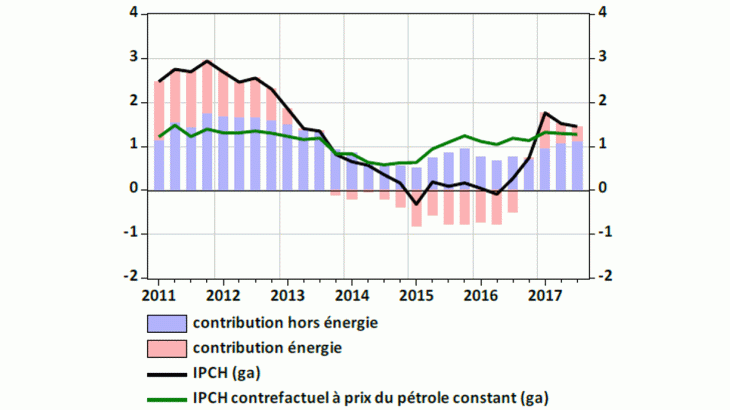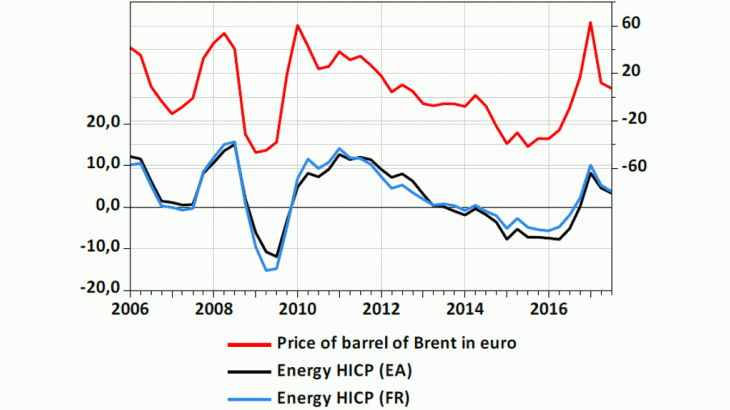Post n°50. A EUR 10 rise in the price of oil results in a 0.4% increase in consumer prices in France and the euro area. A significant part of this rise can be attributed to the non-energy components of the consumer price index. This indirect effect amounts to 0.1 percentage point in the euro area and 0.15 percentage point in France.

Source: Eurostat, authors' calculations.
Note: at each date, the oil price is assumed to be constant over the two previous years.
Fluctuations in oil prices in recent years have greatly affected consumer price developments in France and the euro area. Oil price movements (Chart 1) pass through very quickly to inflation via the energy component of the Harmonised Index of Consumer Prices – HICP - (around 9% of the total index in France and in the euro area). This component includes notably fuel and heating oil prices that react directly to crude oil prices. Using standard econometric tools, we can quantify the direct impact of oil prices on HICP inflation via this energy component: a EUR 10 rise in the price of a barrel of Brent has a direct and rapid impact (in less than a quarter) on the HICP of 0.3 percentage point for the euro area and of 0.25 percentage point for France. It should be noted that the existence of a tax on the volume and not the value of energy consumption, like the domestic consumption tax on energy products (TICPE) in France, acts as a shock absorber on final energy price fluctuations.

Source: Eurostat
However, the transmission of crude oil price movements does not stop there: oil is used in the production of many goods and services, like chemicals or air transport. It therefore indirectly affects non-energy inflation. In addition to the direct and indirect effects, a third channel may affect inflation: that of "second round" effects leading to an increase in wages via indexation mechanisms (e.g. the minimum wage in France) or via wage bargaining, which feeds back into inflation. This article focuses on the direct and indirect effects of oil price changes, but does not take account of second round effects that occur with a lag.
Assessing the indirect impact of oil prices on inflation
We base this assessment on two simple ideas. First, France and the euro area mainly use imported oil. In 2016, net oil imports stood at 3,200 million barrel of oil equivalent in the euro area and 550 million in France.
Second, the demand for oil is not very sensitive to its short-term price. A EUR 10 change in the price of a barrel of oil therefore mechanically results in a proportional increase in the oil bill, of EUR 32 billion in the euro area, or 0.6% of household consumer spending, and of EUR 5.5 billion in France, or 0.5% of consumer spending.
This increase thus corresponds to the total−direct and indirect−impact on final demand prices, before taking account of any second round effects from the response of wages to the rise in inflation. Based on national accounts input-output tables, we estimate the energy import content of the different items of demand. We find that household consumption accounts for around 60% of the end use of net oil imports in both the euro area and in France, while the remainder is mainly incorporated in the production of exported goods. We then add the oil already contained in imported manufactured goods which also ends up in domestic consumption. By assuming that the production structure of these imported goods is similar to that of the goods produced in the euro area and in France, we calculate that the total oil content of consumption is 65% of the oil bill in the euro area and 73% in France. As Table 1 shows, a EUR 10 rise in the price of a barrel of oil therefore results in a total impact of 0.4 percentage point on the HICP in the euro area, of which 0.3 percentage point is direct and 0.1% is indirect. In France, the total impact is also 0.4 percentage point, of which 0.25 is direct and 0.15 is indirect.
| Direct effect via the energy component | Indirect effect | Total of direct and indirect effects (excluding second round effects) | |
|---|---|---|---|
| EURO AREA | 0.3 | 0.1 | 0.4 |
| FRANCE | 0.25 | 0.15 | 0.4 |
In order to assess the impact of oil price changes on the time path of inflation, it is necessary to know how long oil prices take to pass through to consumer prices. While the transmission of oil prices to inflation via the energy component is very rapid, the indirect effect via production chains is slower and varies across sectors. For instance, our tools for forecasting inflation show an impact of oil prices on services prices (in particular air transport) with a lag of around 4 quarters.
Chart 2 describes HICP counterfactual inflation in the euro area and in France. It shows what the inflation level would have been if oil prices had remained constant, at that of the start of 2014, i.e. EUR 79 per barrel (green curve). This counterfactual approach differs from the simple calculation of the contribution of the non-energy components to the HICP (pale blue bars) in that it takes into account the indirect effects mentioned above, assuming that the transmission of oil prices is complete after two years.

Note: at each date, the oil price is assumed to be constant over the two previous years
According to our estimates, with no oil price fluctuations, euro area inflation would have remained contained at 1.5% in 2011−12 instead of around 3%. Then, it would have fallen to 0.6% in 2014−15, instead of becoming negative, and would have risen in 2015 to around 1.0%. It would have stabilised overall at this level since 2015. Oil price movements would have been similar in France, with a temporary trough of 0.3% in 2015, but prices would have then risen to around 0.9% by the end of the same year.
As shown in Chart 2, the direct and indirect impact of oil prices, which do not respond to monetary policy, only partly explain HICP developments. While it explains well the period of disinflation between 2012 and 2015 in the euro area, the fact that the inflation rate has persistently remained well below 2% in recent years is due to other factors, especially domestic factors, which led the Eurosystem to adopt a very accommodative monetary policy stance.
Updated on 10 April 2024